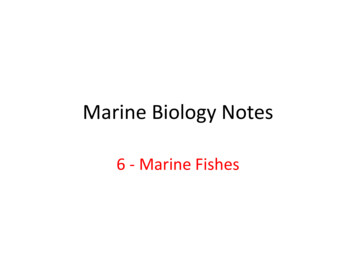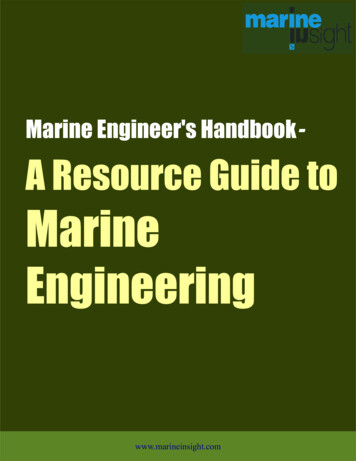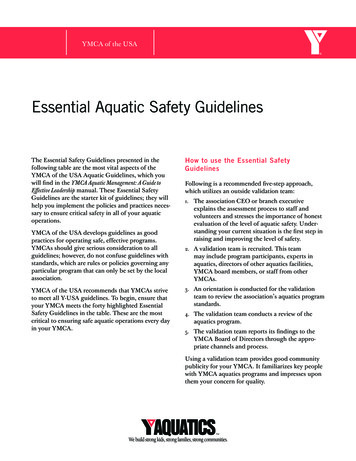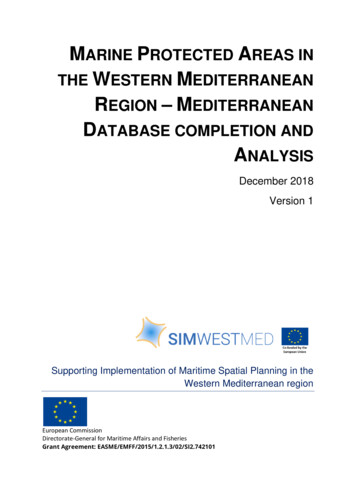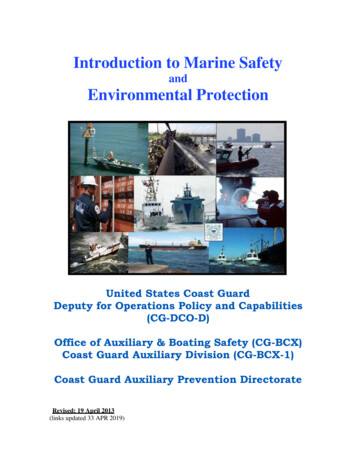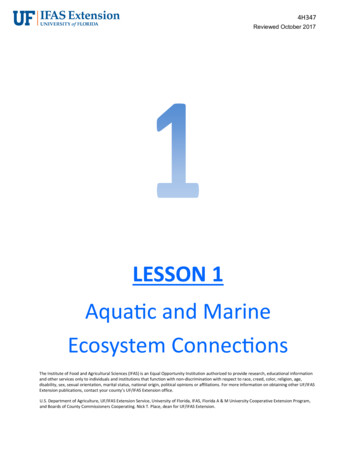
Transcription
4H347Reviewed October 2017LESSON 1Aquatic and MarineEcosystem ConnectionsThe Institute of Food and Agricultural Sciences (IFAS) is an Equal Opportunity Institution authorized to provide research, educational informationand other services only to individuals and institutions that function with non-discrimination with respect to race, creed, color, religion, age,disability, sex, sexual orientation, marital status, national origin, political opinions or affiliations. For more information on obtaining other UF/IFASExtension publications, contact your county’s UF/IFAS Extension office.U.S. Department of Agriculture, UF/IFAS Extension Service, University of Florida, IFAS, Florida A & M University Cooperative Extension Program,and Boards of County Commissioners Cooperating. Nick T. Place, dean for UF/IFAS Extension.
Lesson 1: Aquatic and Marine Ecosystem ConnectionsLESSON 1: Aquatic and Marine Ecosystem ConnectionsOBJECTIVES: For youth to: Describe and identify Florida’saquatic/marine ecosystems. Describe the stages of thehydrologic cycle. Discover the effects of abioticfactors on aquatic/marineecosystems. Develop an understanding ofenergy flow and how foodchains function. Discover interrelationshipsbetween living and nonlivingcomponents of aquatic/marineecosystems. Identify stages of aquaticsuccession. Describe ways in which humansvalue and depend uponaquatic/marine ecosystems.MATERIALS:Maps of Florida: 1 per 5-6 youth (astate highway map will work)Copies of ECOSYSTEMS DEFINEDActivity Sheet (1 for each youth)TIME: 45 minutes to 2 hours (forfield trip)ADVANCED PREPARATION:Read the BACKGROUND BASICS onAquatic/Marine EcosystemConnections. Review activities andchoose those appropriate for yourgroup. Obtain the materialsdescribed at the start of eachactivity.PURPOSE:To become familiar with and differentiate between basicphysical and biological factors common to all aquatic/marine systems.DO:Here are some learning activities and suggested ways toimplement the activities in Lesson 1.1.1Discover and understand Florida's many diverseaquatic/marine ecosystems with WHAT'S ANECOSYSTEM?1.2Learn how one critical factor affects differentecosystem communities using SALT OR NO SALT,WHAT’S THE DIFFERENCE?1.3Identify the stages of the hydrologic cycle withWATER BASICS.1.4Play ABIOTIC INFLUENCE,1.5AQUATIC FOOD CHAINS, and1.6FOOD WEBS: STRINGS ATTACHED to discover therelationships and interdependence between theliving and non-living parts of ecosystems.1.7Discover some different stages of AQUATICSUCCESSION.1.8Complete AQUATIC / MARINE VALUES to identifythe many ways aquatic/marine ecosystems areimportant to humans.2
Lesson 1: Aquatic and Marine Ecosystem ConnectionsREFLECTAfter completing each activity in this lesson, help youth reflect on what theyhave learned with these questions: How many different aquatic/marine ecosystems can you name?Swamps, marshes, bogs, rivers, streams, springs, lakes, ponds, bays, beaches, estuaries,mangroves, gulfs, oceans, coral reefs. What are four stages of the hydrologic cycle?Precipitation, transpiration, evaporation, and condensation. Define "abiotic factor" and list some examples.A nonliving part of an ecosystem. Some examples are water temperature, depth,salinity, wave motion, and sunlight. What is a food chain?The transfer of energy from the sun to primary producers to consumers. What happens if one component of a food chain is removed?The other components may also be affected.APPLY Help youth to apply what they have learned to their daily lives.What human values are associated with aquatic/marine ecosystems?Aquatic/marine ecosystems are important resources for many reasons including;economic values (food and transportation), aesthetic values (beauty and serenity),recreation values (fishing and boating), education values (marine science and botany),and health values (nutrition and drinking water). How does human activity affect these aquatic/marine ecosystems?Marine debris, storm water runoff, pollution, dams, and coastal development are someexamples of human impacts on aquatic/marine ecosystems. How can we conserve our aquatic/marine ecosystems?By taking responsibility for our actions on aquatic/marine ecosystems to ensure ourcontinued use and enjoyment, as well as for the survival of all species that depend onthese ecosystems.3
Lesson 1: Aquatic and Marine Ecosystem ConnectionsBACKGROUND BASICSWater . . . Earth's unique and precious resource. Earth is the only planet in our solar systemwith the necessary atmospheric conditions to allow water to exist as we know it. Water isessential to all life on earth. Plants and animals are composed mostly of water. Human bodiesare made up of 95% water. Humans may survive for long periods of time without food, butcan survive no longer than a few days without water. We depend on water not only for thephysical makeup of our bodies, but also for the environment it provides while moving throughits three states. Water is the only substance found on earth that occurs naturally in threeforms, solid, liquid, and vapor.THE WATER CYCLEThe water cycle is a familiar, yet a dynamic mechanism which continually moves throughoutall ecosystems. It is a natural process which has no beginning or end. The cycle is driven byenergy from the sun that causes the evaporation of water from land and water surfaces andtranspiration of water from plants. Transpiration occurs when water absorbed by plant rootsis drawn through the body of a plant and then evaporates from the surface of leaves andstems. As water vapor rises, it cools, and condenses into clouds. When the water once againfalls to the Earth's surface as rain, snow, sleet, and hail, it is called precipitation. Once on thesurface, the water may immediately evaporate back into the atmosphere or run off intostreams, rivers, and other water bodies. Surface water may also infiltrate the ground where itwill eventually reenter the cycle through groundwater discharge or transpiration by plants.In Florida, precipitation falls almost exclusively as rain, with occasional snow and hail. The dryseason extends from October through May, and the wet season from June throughSeptember. Convective rains or thunderstorms occur in late afternoon in the spring andsummer. Tropical low pressure storms from theAtlantic Ocean and the Caribbean Sea occur from latesummer into early autumn. Fronts from the NorthAmerican continent sweep the state during the fall,winter, and early spring. Tropical storms andhurricanes may cause heavy rainfall during the wetseason. Seasonal fluctuations in precipitation cangreatly affect water resources.4
Lesson 1: Aquatic and Marine Ecosystem ConnectionsSurface runoff is the water which directly flows across the land into streams, rivers, or lakes.As water moves over the land, it may be seen as sheet runoff, or rills and gullies. Sheet runoffcan be easily seen on a parking lot, whereas rills and gullies may be best observed on a slopeof bare soil. Water that does not run off infiltrates (soaks into) the ground. When it travelsthrough the soil, it may be absorbed (taken up) by the root systems of plants and used fortheir physiological processes.Water not used by plants either adheres to soil particles or continues to move through the soilin all directions. Eventually the water will reach bedrock or a totally saturated zone in the soil.The top of this zone is called the water table. Water below the water table is calledgroundwater. Where the water table reaches the ground surface, it may appear as a spring orit may move directly into a flowing stream. This concept is important because without thesubsurface movement of water and subsequent recharge of surface water, many streamswould not flow between precipitation events. Subsurface drainage may be fast or very slowdepending on soil types, depth to bedrock, slope and other climatic and geologic factors.Water that reaches bedrock can move through cracks and fissures in the rock structure. Itmay move slowly through the rock formation or remain in place for hundreds of thousands ofyears. A rock formation that holds vast amounts of water is called an aquifer, a term derivedfrom the two Latin words "aqua," meaning water, and "ferre," meaning to bear or carry. InFlorida, we have the huge and deep Floridan Aquifer and the more shallow Biscayne Aquifer,which together provide nearly 90 percent of the state's drinking water, irrigation water,recreational water, and waste disposal water (Myers and Ewell, 1990).People withdraw water from groundwater and surface water resourcesfor their daily domestic and economic needs. These uses of water cangreatly affect the natural recharge of stream flows and groundwater.Development projects that involve the removal of natural land areasand paving over large soil surface areas may have adverseenvironmental impacts on soil erosion, stream flow levels, and thenatural recharge of groundwater resources. Our utilization of thisresource is a necessity, and with careful planning, adverseenvironmental impacts resulting from our interruption of the naturalwater cycle can be minimized.5
Lesson 1: Aquatic and Marine Ecosystem ConnectionsECOSYSTEMSAll plants and animals require water, but in varying amounts. The amount of water and othernonliving factors in an area determine the types of plants and animals that can exist there. Acommunity is all of the living things in a given area. The community and the nonlivingenvironment function together as an ecosystem. Ecosystems are made up of both the living,biotic component, and the nonliving, abiotic, component. The abiotic component of an arealargely determines what types of life forms can exist there. Water is one abiotic component,but there are many others such as soil type, elevation, temperature, salinity, etc.Florida has many very diverse types of ecosystems. Oneof the reasons for this diversity is that the northern partof the state is situated in the temperate zone and thesouthern part of Florida extends into the subtropics.Although the State does not have diverse topography,changes in elevation have a significant effect on Florida’secosystems. In the higher elevations are pine flatwoods,dry prairies, scrub and high pine habitats, andtemperate hardwood forests. In south Florida, rockland ecosystems consist of pinelands andtropical hardwood hammocks. In the lower areas are swamps and freshwater marshes. Alongthe coast, are dunes and maritime forests. Florida has approximately 7700 lakes, more than1700 rivers, and over 300 artesian springs (Myers and Ewell, 1990). Most of the larger riversdischarge at the oceans, emptying into estuaries, salt marshes, and mangroves. Florida'scoastal areas and marine ecosystems are also quite diverse, from the beach dune communityto several different offshore reef communities.Aquatic/Marine EcosystemsAquatic/Marine ecosystems are located in areas that are eithercovered with water for part of the year, or are underwater all ofthe time. These ecosystems may be divided into four maingroups: freshwater wetlands, including swamps, marshes, andbogs; other freshwater ecosystems, including rivers, springs,lakes, and ponds; coastal ecosystems, including estuaries,beaches, mangroves, salt marshes and mud flats; marine6
Lesson 1: Aquatic and Marine Ecosystem Connectionsecosystems, including oceans, coral reefs and sea grass beds (which can be estuarine as well).Each of these ecosystems will be studied in upcoming, individual lessons.Although the various ecosystems may seem verydifferent and isolated from each other, it is importantto realize how they are interrelated. For example,many of the rivers in Florida are brown in color fromthe tannin released by decaying vegetation thatcomes from surrounding swamps and forests. Riverscarry detritus (partially decomposed plants and otherorganisms) downstream, where the nutrients areemptied into estuaries which support the nurseries ofthe sea. Many forms of wildlife utilize and depend onmore than one ecosystem for survival. An osprey may nest in a hardwood swamp, but catchfish for its food in the ocean. Many species of saltwater fish spend most of their adult lives inthe ocean but depend on estuaries or rivers for their breeding and spawning grounds.Energy Flow in the EcosystemsThere are complex relationships not only amongdifferent ecosystems, but also within each ecosystem.Many of these relationships involve the transfer ofenergy. The source of energy for ecosystems is thesun. This flow of energy from one organism to thenext is known as a food chain. A food web is theinterconnected pattern of separate food chains in acommunity. Green plants, called producers, utilizesunlight to make their own food through the processof photosynthesis. Animals that feed on the producers are called primary consumers, alsocalled first order consumers. Secondary consumers, also called second order consumers, feedon the primary consumers. Third and fourth order consumers may also exist within anecosystem.The last major category is the decomposers which consist mainly of bacteria and fungi. Theseorganisms break down organic matter or detritus into nutrients which may be recycledthrough the ecosystem.7
Lesson 1: Aquatic and Marine Ecosystem ConnectionsThere are a number of factors which influence the amount and types of organisms that aaquatic/marine ecosystem will support. It is important to understand the major factors and tobe able to communicate to the youth just how these factors fit together. Vertebrate,invertebrate, and plant populations in an aquatic ecosystem are not only influenced by thesize of the area, but by a variety of abiotic factors including soil fertility, water depth, turbidity,temperature, and water quality.Populations are also affected by the relationships within an ecosystem’s food web. Forexample, various fish populations have different food requirements. A bass would requiresmall fish and large invertebrates such as crayfish. A bluegill would depend on smallinvertebrates such as aquatic insects, or zooplankton. Therefore, the number of individualswithin a population of bass and bluegills that a pond could support directly depends on theamount of food available.It must be understood that a pond, like other ecosystems, willhave a balance between predators and prey, and this balance isnecessary to maintain the homeostatic (relatively stable stateof equilibrium) nature of the ecosystem. It can be said that anecosystem maintains a state of dynamic equilibrium. Numbersand species of organisms within the system constantly change.Populations increase and decrease, dependent upon foodsupply and other biotic and abiotic factors. Even with thisdynamic system, a state of balance is almost always maintainedthrough a variety of self-regulating factors that includepredator/prey relationships, death rates, birth rates, andamount of habitat.Ecological SuccessionEcological succession is the progressive change in the plants and animals (biotic), andnonliving (abiotic) factors of an ecosystem over time. The new plant and animal community istypically more stable and complex than the previous one. During succession, a communitymodifies its physical environment so much that it creates conditions which are unsuitable foritself. Subsequently, a different group of species will eventually dominate the community.8
Lesson 1: Aquatic and Marine Ecosystem ConnectionsThe change from one community to another takes place gradually, as the composition of anecosystem changes. Early stages in certain successional patterns might evolve over a relativelyshort period of time, sometimes in as few as ten years. Later successional stages may takemuch longer to evolve into new and unique communities.Succession occurs in both aquatic and terrestrial ecosystems. In aquatic ecosystems such asponds and lakes, succession takes place as sediments accumulate. In salt marshessedimentation rates may vary due to tides and storms, however, succession still occurs. Earlymarsh plant species trap sand and soil to build land upon which new plant communities maygrow. An example of succession in a coastal ecosystem is the change from bare sand dunes tothose covered with sea oats. The sea oats may then trap and hold soil and support additionalplant life.Eutrophication is the "aging" of a water body due to the addition of organic matter. Althoughit is a natural process, human activities can accelerate the eutrophication of a water body.Sewage and agricultural runoff can add nutrients and sediments to the water. Thus,succession may occur much faster than normal. Soil erosion in surrounding areas maycontribute to eutrophication as well, by adding soil to the sediment layer.CONCLUSIONThroughout this curriculum, the focus is on aquatic/ marine ecosystems in Florida. However,many of these ecosystems occur in other locations and most of the concepts explored areuniversal. Through participation in the activities of this curriculum, an appreciation of thecomplexity and values of aquatic/marine ecosystems may be developed. The goal is toeducate youth concerning these resources to provide them the basis to make informed,intelligent decisions concerning the environment and our future.9
Lesson 1: Aquatic and Marine Ecosystem ConnectionsActivity 1: What is an Ecosystem?OBJECTIVES: For youth to: Define Florida's aquatic/marineecosystems. Locate examples of ecosystems ona map of Florida. Develop an understanding of theinterrelatedness of theseecosystems.LIFE SKILLS Acquiring, analyzing and usinginformation. Working in groups.SUNSHINE STATE STANDARDS:GSS.1.G.1.1: Use physical and political/cultural maps to locate places in Florida.SS.1.G.1.5: Locate on maps and globesthe student's local community, Florida,the Atlantic Ocean, and Gulf of Mexico.SC.912.L.17.2: Explain the generaldistribution of life in aquatic systems asa function of chemistry, geography,light, depth, salinity, and temperatureSC.912.L.17.7: Characterize the bioticand abiotic components that definefreshwater systems, marine systemsand terrestrial systems.INTRODUCTIONWhat is an ecosystem? An ecosystem consists of bothliving and nonliving things (a group of plants and animalsand their environment) that function together as a unit innature. An aquarium is a mini-ecosystem. The fish,plants, and snails are the living parts and the water, light,and heater are the nonliving parts of the environment.Florida has many different kinds of ecosystems. Some ofFlorida's ecosystems are called aquatic and marineecosystems. These ecosystems are located in areas thatare either covered with water for part of the year or arecompletely under water all of the time. There are manytypes of aquatic/marine ecosystems in Florida. Thedifferences among these ecosystems are in their location,amount of water, the plants and animals that live there,and whether the water is fresh or salt. Ecosystems maybe affected by manmade factors in the surrounding area,such as agriculture, forestry, urban development, andpollution runoff. Aquatic and marine ecosystems mayalso affect each other. For example, a spring may flowinto a river, and the river might flow through a swampand empty into an ocean.Let's learn about Florida's different "water" ecosystems!MATERIALS: Maps of Florida - 1 per 5-6 youth(a state highway map will work) Copies of ECOSYSTEMS DEFINEDActivity Sheet (1 for each youth)TIME:30 minutesSETTING: Comfortable room with tablesand chairs or outside with tables.ADVANCE PREPARATION:Read background basics. Obtain FloridaState Highway map.10
Lesson 1: Aquatic and Marine Ecosystem Connections - Activity 1.1 What is an Ecosystem?DO Divide youth into groups of 5-6. Distribute highway maps and copies of ECOSYSTEMS DEFINED Activity Sheet. Read and discuss definitions. Locate examples of each type of ecosystem on a map. Perhaps use GPS or explain whenusing internet. Locate a river on the map. Identify its source (where it begins) and trace the river's path towhere it discharges (ends).Identify the different aquatic ecosystems associated with this river. For example, theSuwannee River originates in the Okefenokee Swamp. Along its course, the Withlacoochee,Alapaha, and the Santa Fe Rivers join the Suwannee. Many springs, including Manatee Spring,empty into the Suwannee River, which then discharges into the Gulf of Mexico.REFLECT What are some of the differences among Florida's aquatic/marine ecosystems?Some examples of differences are location, amount of water, kinds of plants andanimals, salt or freshwater. Which aquatic/marine ecosystems have trees in them?Some wetland and coastal ecosystems. Which aquatic/marine ecosystems contain saltwater?Coastal and marine ecosystems such as estuaries, oceans, bays and coral reefs. Name the aquatic/marine ecosystems that occur inland, away from the coastline.Wetlands such as swamps and marshes, and other freshwater ecosystems like lakes,rivers, and springs. Why did you look at a map? What other kinds of maps are there? What can you learnby using them?We looked at a map to find the different aquatic/marine ecosystems in Florida. Thereare road maps, topographic maps, and globes which can be used to learn about roads,elevations, and geography.11
Lesson 1: Aquatic and Marine Ecosystem Connections - Activity 1.1 What is an Ecosystem?APPLY Have youth identify aquatic/marine ecosystems in their area. Ask youth to discuss aquatic/marine ecosystems they have visited and identify the type ofecosystem. Discuss how a pollutant introduced in one ecosystem may affect many others.For example, think about the river traced on the map and how a pollutantentering at the source could make its way through many ecosystems all theway to the river's discharge. Discuss the plants and animals that might beaffected along the way.12
Lesson 1: Aquatic and Marine Ecosystem Connections - Activity 1.1 What is an Ecosystem?ECOSYSTEMSDEFINEDWetland EcosystemsWetlands are areas of land that are covered with water for at least part of the year, for anylength of time from a week to the entire twelve months. Some examples of wetlands areswamps, marshes, and wet prairies. Most wetlands contain freshwater, but some, like saltmarshes along the coast contain saltwater, too. Wetland plants include: grasses, herbs,shrubs, and/or trees. Wetlands are home to many kinds of fish, frogs, turtles, snakes, birds,and mammals. There are many threatened and endangered species of plants and animalsthat are dependent on wetlands such as the wood stork, Southern bald eagle, Florida blackbear, and the Florida sandhill crane.Freshwater EcosystemsFreshwater ecosystems are inland aquatic ecosystems such as rivers, streams, ponds, lakes,and springs. Freshwater ecosystems contain little to no salts in their water. Many kinds offish, frogs, turtles, and snakes live in freshwater. Birds such as osprey and herons, as well asmammals, like otters, may also live in or near freshwater ecosystems and are dependent onthem for food.13
Lesson 1: Aquatic and Marine Ecosystem Connections - Activity 1.1 What is an Ecosystem?ECOSYSTEMSDEFINEDCoastal EcosystemsCoastal ecosystems are saltwater or brackish ecosystems along the coastlines of Florida suchas beaches, estuaries, mangroves, and bays. Brackish water occurs where freshwater andsaltwater mix together. An example of a brackish ecosystem can be found where afreshwater river empties into the ocean along the coastline. Many kinds of saltwater fish,turtles, and crabs and shellfish live in coastal ecosystems, and many more animals use theseecosystems as nurseries. Birds like pelicans and seagulls may live in the trees in themangroves and eat fish from the water in the estuaries and bays. Mammals such as beachmice and bobcats also live in or near coastal ecosystems.Marine EcosystemsMarine ecosystems are saltwater ecosystems that are beyond the shoreline, such as oceans,gulfs, and coral reefs. Plants in marine ecosystems consist mainly of algae. In shallow areas,sea grasses may grow as well. Some animals in marine ecosystems include sponges, corals,fish, shellfish, turtles, sharks, dolphins, and whales.14
Lesson 1: Aquatic and Marine Ecosystem ConnectionsActivity 2: Salt or No Salt: What’s the Difference?OBJECTIVES: For youth to: Taste the “ocean.” Visualize the process of osmosisDiscover how fish cells respond to freshand salt water. Distinguish the adaptations salt andfresh water fish have made in theirenvironment.LIFE SKILLS Acquiring, analyzing, and usinginformation.SUNSHINE STATE STANDARDS:SC.4.N.1.1 (or substitute 5 for 5th grade, 6for 6th grade): Raise questions about thenatural world, use appropriate referencematerials that support understanding toobtain information (identifying the source),conduct both individual and teaminvestigations through free exploration andsystematic investigations, and generateappropriate explanations based on thoseexplorations.SC.4.N.1.4: Attempt reasonable answers toscientific questions and cite evidence insupport.SC.4.N.1.6: Keep records that describeobservations made, carefully distinguishingactual observations from ideas andinferences about the observations.SC.5.N.1.4: Identify a control group andexplain its importance in an experiment.MATERIALS: Copies of SALT OR NO SALTOBSERVATION Sheet (1 per youth) 16 oz. Paper or plastic cups (1 peryouth) Tap water Table saltLEADER INFORMATIONOsmosis is the movement of a dissolved substanceacross a membrane (as in a living cell) from areas of highconcentration to lower concentration. In a saltwaterenvironment, water moves out of fish cells into the saltywater because there are more salt particles in the waterthan in the fish cells. Since so much water is moving outof a fish that lives in saltwater, the fish makes up for it bydrinking a lot of seawater. The fish gets rid of the extrasalt from the water through its gills. The oppositeprocess happens in fish that live in freshwater. Water isabsorbed into the fish because the surrounding water isless salty than the cells in the fish. These fish get rid ofthe extra water through their kidneys. Fresh and saltwater fish have special and different ways of dealing withtheir environments and the results of osmosis.INTRODUCTIONIf we stir a teaspoon of salt into a glass of water, wheredoes the salt go? It dissolves in the water. This is similarto the saltwater in marine ecosystems. Salts comingfrom terrestrial deposits are usually dissolved in waterand flow into the seas and oceans. Evaporation thenresults in further concentrating the salts to a level ofapproximately 3.5 percent in most open ocean areas.Measuring spoonTwo shallow bowls for every 2-4 youthOne small cucumberSmall knifeMasking tapeMarkerPencils/pensTIME:90 minutesSome fish live in freshwater and some fish live insaltwater. If the water is different, do you think the fishare different too? Let’s conduct an experiment to findout about this. We will use cucumber slices todemonstrate the movement of water from an area withless salt into an area of higher salt concentration. Thatprocess is called “osmosis.”SETTING: Room with tables and chairs.ADVANCE PREPARATION: Gather allnecessary materials listed above. Check tosee is any youth are on salt restricted diets.Let's taste the “ocean” and then we’ll see how fish cellshave adapted to fresh and saltwater.15
Lesson 1: Aquatic and Marine Ecosystem Connections - Activity 1.2 Salt or No Salt: What’s the DifferenceDO Fill two bowls each one-half with water. Stir one teaspoon of salt into one of the bowls labeling this bowl "saltwater" using the tapeand marker. Have an adult cut the cucumber into thin slices. Bend the slices back and forth todetermine their flexibility and record on the OBSERVATION chart. Place three cucumber slices into each bowl. Wait 30 minutes. While waiting 30 minutes, do the following: Have each youth fill a cup (6 oz.) with warm tapwater. Add a teaspoon of table salt to each cup andstir. Have each youth taste their "mini-ocean." Answer the first three Reflect questions. After the 30 minutes, check the cucumber slices: Remove the slices and determine their flexibility by using your fingers to bend them backand forth and record on the OBSERVATION chart. Switch the slices by placing the slices that were in the saltwater into the plain water andthe slices that were in the plain water into the saltwater. Wait 30 minutes. After the second 30 minutes, remove the slices and determine their flexibility. Complete the OBSERVATION chart.REFLECT What happened when you stirred the salt into the water? Is it still there?Yes, it's still there - you just can't see it because the salt "dissolved" into the water.16
Lesson 1: Aquatic and Marine Ecosystem Connections - Activity 1.2 Salt or No Salt: What’s the Difference? Why are oceans salty?Oceans and seas are salty because salts and minerals from rocks have dissolved inthese large bodies of water. Since salts and minerals don't evaporate, they stay in theoceans and seas. Does real seawater taste like your "mini-ocean"?Seawater tastes similar, but oceans and seas contain many different kinds of salts inaddition to sodium chloride (NaCl), which is table salt. Which cucumber slices are limp?The slices in the saltwater are limp. Why are they different from the slices in freshwater?Water moved out of the cells of the cucumber slice in the saltwater, leaving it limp,like a full water balloon that has lost some of its water. When cells lose some or all oftheir water, they are dehydrated. Dehydration means without hydration (water). When you eat something salty, like potato chips or popcorn, do you get thirsty? Why?The salt dehydrates some of your cells, and makes you thirsty, just like a saltwaterfish that drinks a lot of water. What would happen if a freshwater fish was put in saltwater?Because most freshwater fish do not have the adaptations saltwater fish have, thefreshwater fish would dehydrate like the cucumber slice did in the sal
LESSON Aquatic and Marine Ecosystem onnections. 4H347. The Institute of Food and Agricultural Sciences (IFAS) is an Equal Opportunity Institution authorized to provide research, educational information and other services only to individuals and institutions that function with non-discrimi



